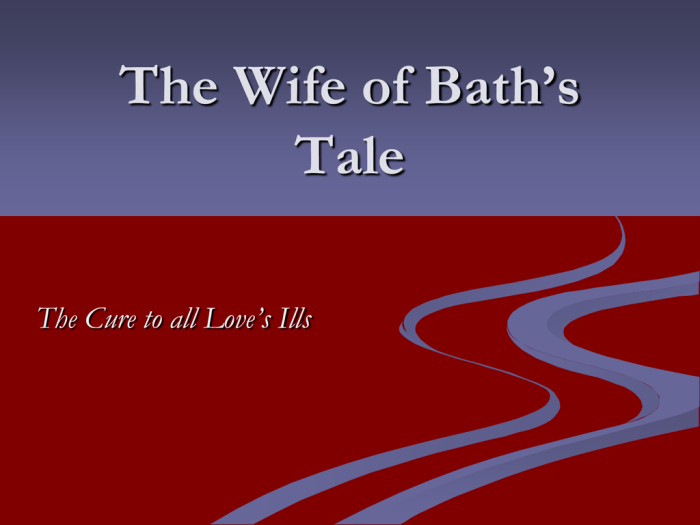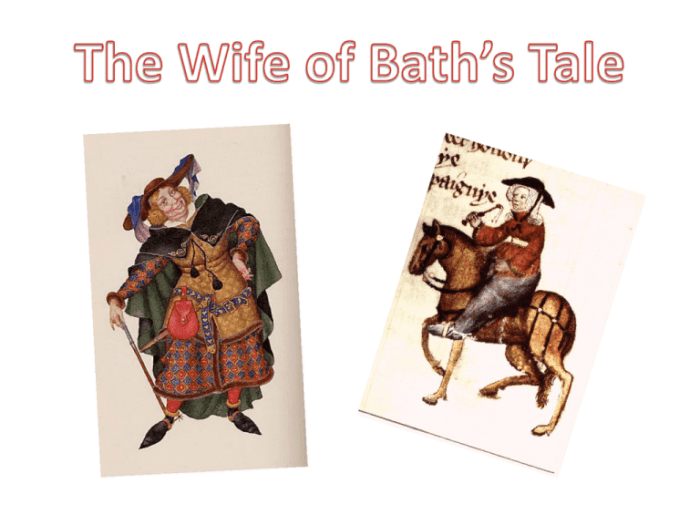The wife of bath’s tale quiz – Prepare to delve into the fascinating world of Chaucer’s Canterbury Tales with our engaging Wife of Bath’s Tale quiz. Embark on a journey through this captivating narrative, where a vibrant cast of characters, thought-provoking themes, and clever literary techniques await your discovery.
Immerse yourself in the rich tapestry of the Wife of Bath’s experiences, motivations, and beliefs. Unravel the complexities of medieval society and its influence on the tale’s characters and themes. Through this quiz, you will gain a deeper understanding of this beloved literary masterpiece and its enduring relevance.
Wife of Bath’s Tale Overview

The Wife of Bath’s Tale holds significant importance within the Canterbury Tales. It is a story within a story, narrated by the Wife of Bath herself, and is known for its exploration of themes such as marriage, gender, and social hierarchy.
Main Characters and their Roles
The main characters in the Wife of Bath’s Tale are:
- The Wife of Bath:The narrator of the tale, who shares her experiences and views on marriage.
- The Knight:A young, handsome knight who rapes a young maiden.
- The Old Woman:A wise and mysterious figure who helps the knight learn the true meaning of love.
Plot Summary
The Wife of Bath’s Tale follows the story of a young knight who is sentenced to death for raping a maiden. The knight is given a chance to redeem himself by finding out what women truly desire. He travels the countryside, asking women what they want, but receives conflicting answers.
Finally, he meets an old woman who tells him that women want sovereignty over their own bodies and the freedom to choose their own destiny. The knight returns to the court and tells the king the old woman’s answer. The king is impressed by the knight’s wisdom and spares his life.
The knight then marries the old woman, who transforms into a beautiful young woman.
Character Analysis: The Wife of Bath: The Wife Of Bath’s Tale Quiz

The Wife of Bath, a complex and captivating character from Geoffrey Chaucer’s “The Canterbury Tales,” stands out as a bold, independent, and outspoken woman who challenges societal norms and defies traditional gender roles. Her character analysis reveals a woman driven by her experiences, beliefs, and unwavering determination to live life on her own terms.Her
experiences as a five-time widow have profoundly shaped her views on marriage and gender dynamics. Having been married to a range of men, from a knight to a carpenter, she has developed a cynical outlook on love and marriage, believing that women are often treated as inferior and exploited by men.
This has led her to assert her own authority and autonomy, refusing to conform to the submissive role typically expected of women in her time.
Motivations, Beliefs, and Values
The Wife of Bath’s motivations are primarily driven by her desire for power, equality, and respect. She believes that women should have the same rights and opportunities as men and is not afraid to speak her mind or take action to achieve her goals.
Her beliefs are rooted in her own experiences and observations, which have led her to conclude that women are capable and deserving of respect and autonomy.She values independence and self-reliance above all else. Having supported herself financially through her various marriages, she has learned the importance of being able to provide for herself and not rely on men for her well-being.
This has fostered a sense of empowerment and self-assurance that sets her apart from many of her female contemporaries.
Themes and Symbolism
The Wife of Bath’s Tale delves into several prominent themes that resonate with the human experience. One of the central themes is the nature of marriage and the power dynamics within it. The Wife of Bath, a strong and independent woman, challenges traditional gender roles and advocates for women’s agency in relationships.
The tale also explores the theme of social class and the ways in which it shapes individuals’ lives. The Knight’s transformation from a wealthy and powerful figure to a humble servant highlights the fluidity of social status and the importance of humility.
Symbolism and Allegory
The Wife of Bath’s Tale employs a rich tapestry of symbolism and allegory to convey its themes. The loathly lady, who is both physically repulsive and sexually desirable, symbolizes the complex and often contradictory nature of human desire.
The Green Knight, with his emerald skin and otherworldly appearance, represents the unknown and the challenges that life presents. His beheading game serves as an allegory for the trials and tribulations that individuals must face to achieve growth and self-discovery.
These symbolic elements contribute to the tale’s overall meaning, inviting readers to reflect on the complexities of human relationships, the fluidity of social status, and the transformative power of adversity.
Historical and Cultural Context

The Wife of Bath’s Tale was written in the late 14th century, during a time of significant social and religious upheaval in England. The Black Death had ravaged the country a few decades earlier, leading to widespread economic and social disruption.
The Hundred Years’ War with France was also ongoing, creating a sense of uncertainty and insecurity.In this context, the Wife of Bath’s Tale reflects the complex and often contradictory attitudes of medieval society. The tale’s themes of marriage, sovereignty, and female agency are all deeply rooted in the social and religious norms of the time.
The Wife of Bath’s Tale quiz is a great way to test your knowledge of the Canterbury Tales. If you’re looking for a challenge, try a student titrated 38.00 ml ! This titration experiment requires careful measurements and calculations, so it’s a good way to practice your chemistry skills.
After you’ve completed the titration, you can return to the Wife of Bath’s Tale quiz and see how much you’ve learned.
Medieval Society and the Wife of Bath’s Tale
Medieval society was highly patriarchal, with men holding most of the power and privilege. Women were expected to be subservient to their husbands and had few legal rights. Marriage was seen as a way to control women’s sexuality and ensure the legitimacy of children.The
Wife of Bath’s Tale challenges these patriarchal norms. The Wife of Bath is a strong and independent woman who has been married five times. She is not afraid to speak her mind and is critical of the double standards that apply to men and women.
Her tale argues that women deserve to be treated with respect and that they have the right to make choices about their own lives.
Religious Attitudes and the Wife of Bath’s Tale
The Wife of Bath’s Tale also reflects the religious attitudes of the time. The Church taught that women were inferior to men and that their primary role was to bear children. However, the Wife of Bath’s Tale challenges this view.
The Wife of Bath is a devout Christian, but she does not believe that women are inherently inferior to men. She argues that women are capable of great things and that they should be treated with respect.The Wife of Bath’s Tale is a complex and multifaceted work that reflects the social and religious attitudes of medieval society.
It is a tale that challenges patriarchal norms and argues for the equality of women.
Literary Techniques

The Wife of Bath’s Tale employs a range of literary techniques to enhance its narrative and convey its themes. Humor, irony, and satire play pivotal roles in shaping the story’s tone and effectiveness.
Use of Humor
Chaucer employs humor throughout the tale to create a lively and engaging atmosphere. The Wife of Bath’s exaggerated descriptions, witty remarks, and bawdy jokes add a comedic element that keeps the reader entertained. This humor serves to lighten the tale’s serious themes, making them more palatable and relatable.
Use of Irony
Irony is another prominent technique used in the tale. The Wife of Bath’s hypocritical nature is a prime example of irony. She preaches about the virtues of chastity and fidelity while openly admitting to her own multiple marriages and sexual escapades.
This irony highlights the gap between the Wife’s words and actions, adding depth to her character.
Use of Satire
The Wife of Bath’s Tale also employs satire to critique societal norms and values. Chaucer uses the Wife’s perspective to satirize the institution of marriage, the power dynamics between men and women, and the hypocrisy of the Church. By presenting these issues through the lens of humor, Chaucer invites readers to reflect on their own beliefs and values.
Contribution to Overall Effectiveness
The combination of humor, irony, and satire in the Wife of Bath’s Tale enhances the story’s overall effectiveness. These techniques create a lively and engaging narrative that draws readers in. They also add depth to the Wife’s character, making her more relatable and memorable.
Moreover, they provide a subtle yet effective way to convey the tale’s themes, encouraging readers to question societal norms and reflect on their own beliefs.
Adaptations and Legacy

The Wife of Bath’s Tale has inspired countless adaptations and interpretations over the centuries, leaving an enduring mark on literature, film, and other art forms.
The tale’s bawdy humor and feminist themes have resonated with audiences, leading to adaptations in various mediums:
Literature, The wife of bath’s tale quiz
- Geoffrey Chaucer’s original text remains a classic work of medieval literature.
- Modern retellings include Chaucer’s Wife of Bath: A Modern Version by Mary Stewart (1982) and The Wife of Bath’s Tale: A Novel by Catherine Cookson (1993).
Film and Television
- The Wife of Bath’s Tale has been adapted into several films, including the 1971 BBC production starring Eleanor Bron.
- The tale has also been featured in television series such as The Canterbury Tales (1972) and The Canterbury Tales: A Medieval Mystery (2003).
Art and Music
- Artists have depicted scenes from the tale in paintings, sculptures, and tapestries.
- Composers have set the tale to music, including Ralph Vaughan Williams in his opera Sir John in Love (1929).
The Wife of Bath’s Tale continues to captivate audiences with its timeless themes of love, marriage, and female empowerment. Its legacy as a powerful and influential work of literature is assured.
Question Bank
What is the significance of the Wife of Bath’s Tale within the Canterbury Tales?
The Wife of Bath’s Tale serves as a pivotal narrative within the Canterbury Tales, offering a unique perspective on marriage, gender roles, and social norms.
Who is the main character of the Wife of Bath’s Tale?
The Wife of Bath herself is the central character, a complex and outspoken woman who shares her views on marriage and female empowerment.
What are the major themes explored in the Wife of Bath’s Tale?
The tale delves into themes such as the power dynamics in marriage, the nature of love and desire, and the role of women in society.